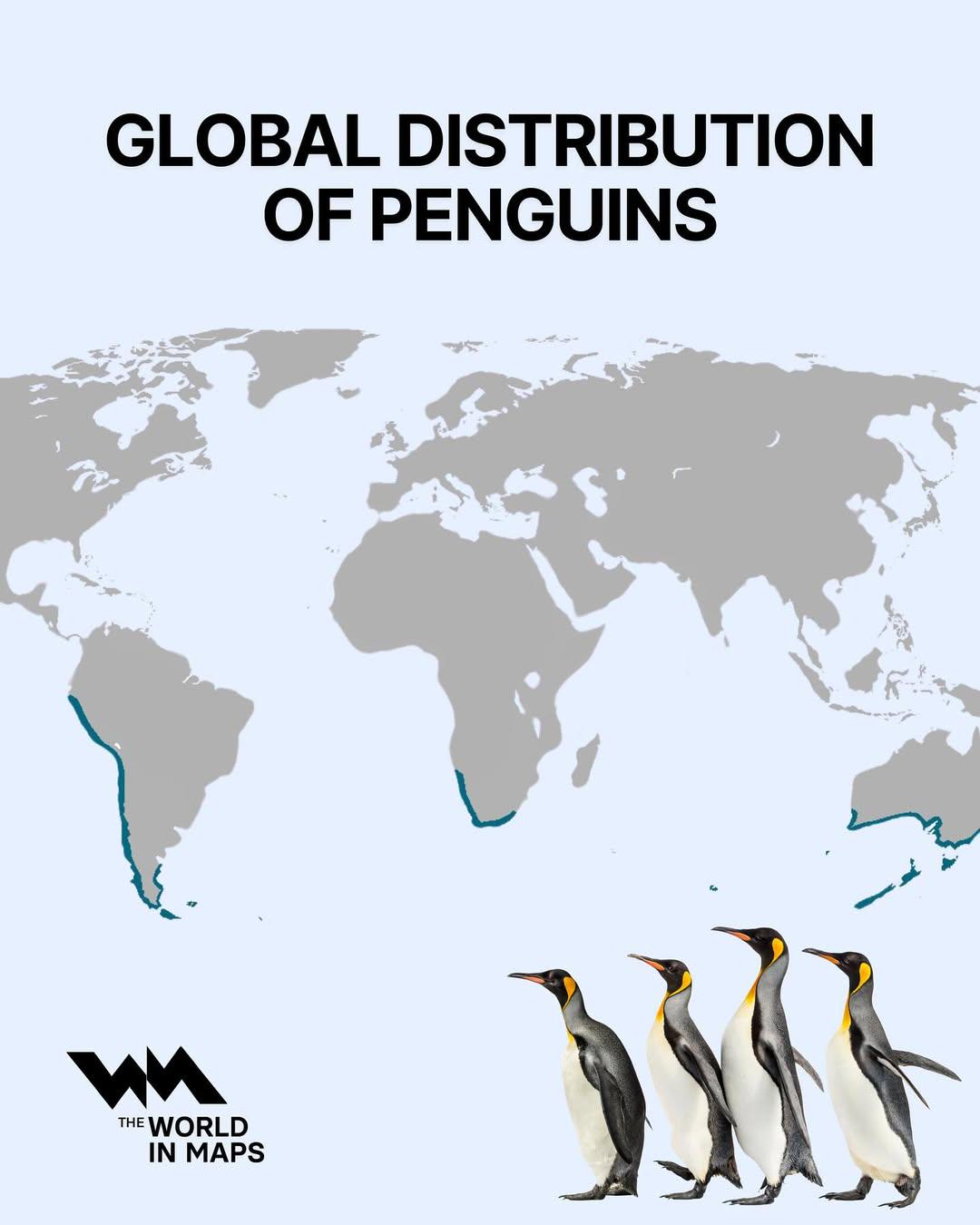Global Distribution of Penguins Map


David Chen
Data Visualization Specialist
David Chen is an expert in transforming complex geographic datasets into compelling visual narratives. He combines his background in computer science ...
Geographic Analysis
What This Map Shows
The 'Global Distribution of Penguins Map' visually represents the habitats and populations of various penguin species across the world. Penguins are primarily found in the Southern Hemisphere, with significant populations located in Antarctica, South America, Africa, Australia, and New Zealand. This map highlights the geographical range of each penguin species, illustrating where they thrive and the environmental conditions they require.
Deep Dive into Penguins
Penguins, with their distinctive black and white plumage and upright posture, are a unique group of flightless birds that have adapted remarkably to life in the water. Currently, there are 18 recognized species of penguins, each with its own specific habitat preferences and ecological requirements. The majority of penguin species are coastal, relying on the rich marine ecosystems for their diet, which primarily consists of fish, squid, and krill.
Interestingly, the largest species is the Emperor penguin, known for its impressive size and the ability to withstand the harsh Antarctic climate. These penguins can dive deep into icy waters to hunt, showcasing their incredible adaptations to extreme environments. The smaller Little Blue penguin, found along the coast of Australia and New Zealand, is quite different, thriving in milder climates and often seen in more temperate regions.
The presence of penguins in various locations is largely influenced by ocean currents and sea temperatures, which affect the availability of their food sources. For instance, the Humboldt penguin inhabits the coasts of Peru and Chile, where cold ocean currents create nutrient-rich waters that support abundant marine life. Conversely, warming ocean temperatures due to climate change pose a significant threat to many penguin populations, disrupting their feeding grounds and breeding cycles.
Moreover, penguins are social creatures that often live in large colonies, which can number in the thousands. These colonies provide protection against predators and facilitate successful breeding. However, their dependence on specific breeding grounds makes them vulnerable to environmental changes, such as habitat destruction and climate shifts.
Regional Analysis
When examining the map's regional distribution, several areas stand out. In Antarctica, for example, the Emperor and Adélie penguins dominate the landscape, thriving on the continent's icy expanse. The Adélie penguin is particularly notable for its remarkable adaptability and resilience, often found in areas that are inhospitable to other species.
Moving northward, we find the Gentoo and Macaroni penguins in the sub-Antarctic islands, such as the Falklands and South Georgia. These islands provide a unique blend of rugged terrain and rich marine resources, making them ideal breeding grounds. Interestingly, the Magellanic penguin can be found along the coasts of Argentina and Chile, often nesting in burrows, which is a behavior not commonly seen in other penguin species.
In Africa, the African penguin, also known as the jackass penguin due to its distinctive braying call, has a more limited range, primarily along the southwestern coast of South Africa. This species faces significant challenges due to habitat loss and overfishing, which have led to a drastic decline in its population over the past few decades.
Australia and New Zealand host the Little Blue penguin, where the temperate climate allows for a different lifestyle compared to its Antarctic relatives. This species is known for its nocturnal behavior and smaller size, demonstrating how environmental factors can shape the characteristics and habits of penguin species.
Significance and Impact
The global distribution of penguins is not just a matter of interest for biologists and ecologists; it carries vital implications for conservation efforts and our understanding of climate change. Penguins are considered indicator species, meaning their health reflects the overall condition of marine ecosystems. As they are highly sensitive to changes in their environment, observing their populations can provide crucial insights into the impacts of global warming and ocean acidification.
Moreover, the ongoing decline in penguin populations raises alarms about biodiversity loss and the health of marine habitats. Conservation efforts are essential to protect these unique birds and their environments. Organizations worldwide work towards establishing marine protected areas and implementing sustainable fishing practices to safeguard penguin habitats.
Interestingly, as climate change continues to alter ocean currents and temperatures, the future of penguins hangs in the balance. Projections suggest that without effective intervention, many species could face extinction within the coming decades. Therefore, understanding their distribution and the factors affecting it is critical for developing effective conservation strategies.
In summary, the 'Global Distribution of Penguins Map' serves as a vital tool for appreciating the geography of these remarkable birds while highlighting the urgent need for conservation efforts to ensure their survival in a rapidly changing world.
Visualization Details
- Published
- September 14, 2025
- Views
- 80
Comments
Loading comments...